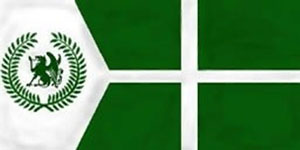Nogovan History

Nogova is a island which is part of the Resistance expansion which was released, my Nogovan Light Infantry are representing years after the main campaign in the game is fought, showing a full army for defence purposes compared to weekend militia as portrayed in the game. The army is responsible for defending the interests of the Nogovan Republic which comprises of Nogova, Everon and Malden.
Nogovan Republic:
The Islands of Nogova, Everon and Malden formed a Republic during the 1980s as a better way of defending itself against soviet aggression, a better way of combining its resources and acting as a single unity for the people of the Malden Islands. Thus the Nogovan Republic was born.
Nogova:
http://community.bistudio.com/wiki/Nogova
Malden:
http://community.bistudio.com/wiki/Malden
Everon:
http://community.bistudio.com/wiki/Everon
Background/History:
The Nogovan Armed Forces:
Following the wars that ravaged the islands in the 1980’s, it was decided that the old militia system of weekend warriors with a minimum of training was insufficient to ensure the defence of the Nogovan Republic. Permanent armed forces based on universal conscription were therefore established, built around a core of former FIA guerilla’s and returned expatriate officers.
The modest resources of the islands of Nogova, Everon and Malden preclude massive investment into modern armaments, leading to an emphasis on acquiring smart soldiers rather than smart weaponry. Rigorous and extensive training programs have been developed to ensure that raw recruits are brought to a high professional standard with a variety of military skills. In joint exercises with Western militaries Nogovan draftees have outperformed the foreign regular counterparts on multiple occasions. All soldiers must pass an extended basic training for a period of six months before entering advanced military training. Part of the soldiers are then enrolled in the combat arms, part in the supporting services. Due to the relatively long initial training all forces have a firm background in basic infantry skills regardless of their subsequent specialisation.
The main part of recruits enter the light infantry which provides soldiers with training for operations in both alpine and desert conditions. Nogovan light infantry doctrine places a high value on dispersed and independent operations by platoon sized units against numerically superior or more heavily armed forces, mimicking the resistance tactics developed in the wars against the Soviets.
Part of the troops are assigned to the armoured corps, which specialises in combined operations with tanks and armoured personnel carriers. The Nogovan Light Horse endorses fast aggressive tactics to quickly disrupt airborne or amphibuous invasions before initial assault forces are able to establish a firm bridgehead. Its reliance on brute force contrasts with the more fluid tactics of the rest of the army.
After basic military training and the light infantry course the best and brightest of the recruits can volunteer for service with the airborne company, undergoing extensive advanced training imparting airborne and amphibuous infiltration techniques, demolitions skills and use of foreign weaponry and equipment. Endurance and initiative are highly stimulated in airborne candidates, a high number of whicheventually enter non commissioned – and subaltern officer training courses at the Viktor Troska Military Institute. The Nogovan Military Constabulary performs various duties in both the civilian and military sphere. Its primary task is that of military police, though it also backs up the national police force with regard to crowd control and by providing an armed
response team for high risk arrests and CT duty. In conjunction with the Fisheries and Customs Enforcement Squadron the NMC acts as the border guard.
Reservist forces are organised into Defense Battalions of uneven size and composition for local defence and support of the regular army’s operations. Their makeup more or less reflects that of the standing army, albeit on a smaller scale. The Defense Battallions consist largely of light infantry with platoon – and company sized combined arms teams. Reservists wear the berets of their former active units, though with the reservist beret badge. Reservists with a good service record can volunteer for six month tours on the Nogovan PfP platoon which has served with UN and
international peacekeeping missions on three continents.
Little is reliably known about the ‘Troska Troop’ or Nogovan Special Air Service which does not even feature on the offical Order of Battle. The existence of thesespecial operations forces is not widely disputed however. No special insignia or other distinguishing marks are attested and it is thought that they usually operate in civilian or in the guise of airborne soldiers to prevent attracting attention. A series of incidents on Russian army bases on Kolgujev in the late eighties and early nineties is sometimes rumoured to have been the work of NSAS operatives, allegedly
including the theft of an attack helicopter later reported ‘lost at sea’ by Russian officials.
The Naval Security Detachment consist of a marine platoon and a small team of assault swimmers and boarding crew. It runs the training courses on amphibious operations for the airborne company and provides security for naval installations.
![Nogovan Armed Forces [NAF]](https://naf.8bit-online.co.uk/wp-content/uploads/2016/01/nogova.jpg)